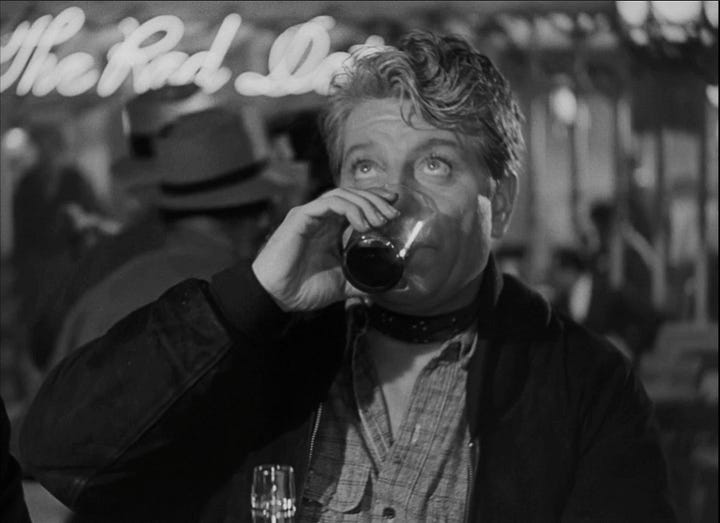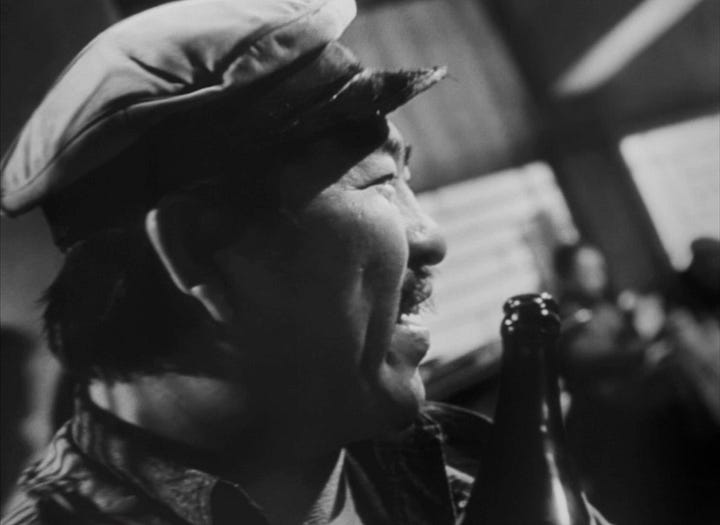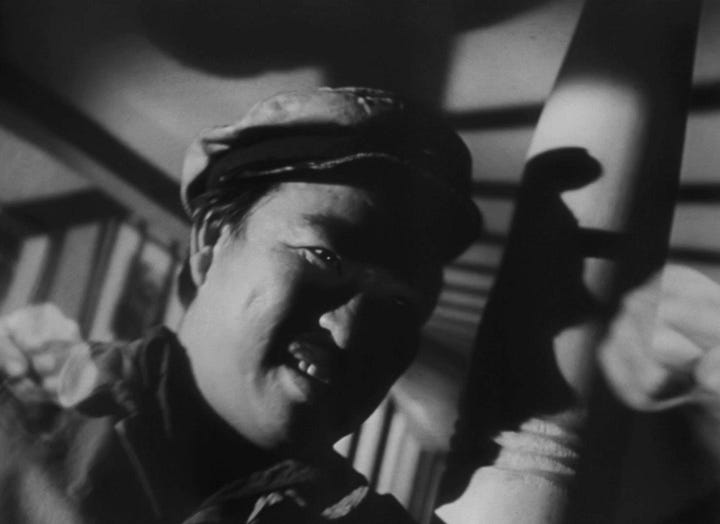Putting Us In Their Shoes: MOONTIDE
This montage from Moontide sees Bobo (Jean Gabin) through a night of drinking . . . and the morning after.
It’s easy to say “slap in some woozy crossfades and spinning camera movements and short disjointed clips and double-exposed shots and CGI tricks” but hard to execute. So let’s bear down on the specifics of how this montage puts us in Bobo’s feeling of ‘having a bit too much.’
POV
The very first cut goes from Bobo’s eyes (with their delectable lashes!) looking upwards to a shot of the ceiling, setting us up to feel what he does even when we’re looking at him and not from his explicit point of view.


Mix and Edit
The editing has an irregular rhythm, or it’s probably more accurate to say the editing takes care not to establish a regular rhythm.
Instead it moves from short clips to longer ones, static takes to moving shots, and gradually starts using more and more double-exposed shots, until the end. The sound mix is also chaotic: the music changes, cross-fading different tunes and ‘stingers’ (short musical effects); phrases “think you oughtta drink that” “I told the guy yes” are repeated off-beat from the music; as the sequence goes it includes more and more sound effects like a punch landing, dog barking, and glass falling.
My favourite is this edit (starting 0:30) cutting right as Bobo knocks over his beer, and as it hits the counter the crossfade takes us into the next clip, where for just a split second it’s superimposed over the bar counter in the next clip.



This edit exemplifies not only how clumsy Bobo is, but how he’s neglecting any ‘boring’ aspects of responsibility or clean up, simply moving on to the next location.
[Re] Using Elements
We see props (the neon sign, the bar glass, the clock, a captain’s hat), characters (the dog, the server, the hot woman), and techniques (the crossfade, the wobbly focus) reappear in different contexts.
For example, the dog seems to be part of his night, but is on the boat; one man appears to be friendly and then sinister . . . and is he wearing the same hat as that other guy, which is the hat Bobo wakes up with!?






This underscores the repetitive nature of Bobo’s night, but also how a drunken memory will blur together things which happened hours or miles apart.
The Morning After
Lest anyone think we're endorsing binge-til-you-blackout drinking, please note: Jean Gabin's character wakes up the next morning to find himself accused of murder, and unable to remember enough to know whether he's guilty or not.
A long, slow dolly back gives that ‘sinking feeling’ as realisation begins to dawn something is wrong, ending with a depiction of Bobo lost in the fog.
Takeaways
Montage is a perfect opportunity not just to ellipse time and have fun, but to give the audience the experience of a character; how you edit (and sound mix) the final thing will have the most impact on your audience.
For the most effective montage, shotlist, shotlist, shotlist, considering how your shots will cut and crossfade, how repeating props or motifs will show up, and what your transition in and out will be.
Soon after, Bobo has some coffee and starts sorting out his life, which involves figuring out what some of those images mean, and the film does return to the characters and events, but though it puts them in context, some never become fully clear, which is also fitting.




